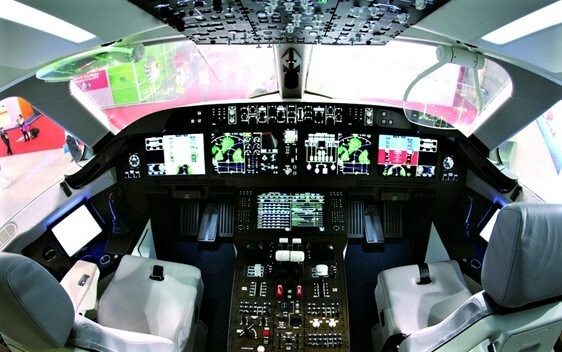China’s 1st China-Build Commercial Airliner with 3D-Printed Parts Completes Maiden Flight

Inside the C919’s cockpit.
IDC reports that the first China-built commercial airliner, the C919, took its maiden flight on May 5th at Shanghai Pudong International Airport in Shanghai, China, marking a key milestone in China’s aviation industry.
The C919 was developed by the Commercial Aircraft Corporation of China Ltd (COMAC), which used 3D-printing technologies and specialty metals such as titanium alloys in the developments of the airliner. COMAC designed and assembled C919 in Shanghai, while the parts of the airliner were manufactured by different suppliers in China. Front parts and wings were made in Chengdu and Xi’an. The main body parts were made in Nanchang.
The successful maiden flight of C919 is said to have demonstrated China’s determination to compete with high-end manufacturing sector in the West. China’s “Made in China 2025” master plan focuses on 10 sectors, one of which is the development of aerospace equipment, as well as 3D printing. The government recognizes that “3D Printing is a strong enabler to China manufacturing’s overall growth.”
3D-Printed Parts
3D-printed titanium parts were installed on the C919 to reduce the airliner’s weight and increase its safety. Twenty-eight cabin-door parts and two fan-inlet structural parts were installed on the C919.
C919 parts were largely made in China, or around 60 percent versus the original target of only 10 percent. However, IDC states that critical parts were still made by foreign suppliers namely CFM International, Liebher-Aerospace, FACC, and Honeywell. CFM International supplied the jet engines and Liebher-Aerospace made the landing gear. Honeywell made the flight-control systems, wheels, brakes, auxiliary power units and navigation systems, while FACC supplied the cockpit.
China’s next target is to increase the parts made locally to 90 percent, and install made-in-China jet engines by 2025. The “aggressive development of China’s aviation industry will lead to increasing demand for 3D printers and metal powders.”
Wendy Mok, research manager of IDC’s Imaging Printing and Document Solutions research, commented: .“We will see more use cases on the adoption of 3D-printing technologies in the aerospace industry. For instance, General Electric (GE) acquired two metal 3D-printer manufacturers, Concept Laser and Arcam, in which they have been providing 3D printers to aircraft parts manufacturers. Jet engine manufacturer Rolls Royce is one of Arcam’s users. Norsk Titanium produces the first Federal Aviation Administration (FAA) approved 3D printed structural titanium components for Boeing Dreamliner.”
Mok added: “In China, the success of C919’s maiden flight implies the use of 3D-printed parts on airliners have been recognized by the aviation industry in China. The domestic demand for 3D-printed parts will grow with expectations that the orders of 570 units of C919 delivered by COMAC in the future, coupled with an increase in localization rate.”
IDC says that suppliers of C919 parts have proven the value of adopting 3D printing in the manufacturing process. Metal 3D printers of foreign brands were used by FalconTech, which supplied a total of 30 metal 3D-printed parts to the C919. Due to reliability and numerous successful use cases in related industries, imported 3D printers are said to hold “a significant competitive advantage over domestic ones in China’s high-end manufacturing sectors.” However, IDC this could create financial burden and resources allocation problems for manufacturers who carry different 3D printers.
“Outsourcing 3D-printing services will save the initial investment cost and enables the manufacturers to focus on product development. Moreover, individual suppliers could provide services and parts according to their product portfolios. Such collaborations will help improve the overall product quality. This business model also provides 3D-printer vendors a point of penetration,” Mok added.
“The local aircraft makers will not be the only ones to benefit from the growing aviation industry, with foreign companies also looking at China’s airliner market. Boeing is planning to build a facility in China, while Airbus have started to assemble their A320s in Tianjin. Moreover, parts supplied by foreign companies could be made in China as well. The huge domestic demand on airliners is attracting more market players and competition. This will further push the growth of 3D-printing industry in terms of both hardware and materials,” Mok added.
According to the IDC Worldwide Semiannual 3D Printer Tracker, China’s metal-based 3D Printer market size in 2016 is 181 units and is expected to grow four-times that in three years’ time.
C919 Highlights Role of 3D Printing
The C919’s successful maiden flight is said to highlight the use of 3D-printing in China’s manufacturing sector. The C919 is also said to further promote the development and applications of new technologies, with more and more companies expected to adopt 3D-printing technologies in their production process.
To achieve the targets set in the “Made in China 2025” master plan, the Chinese government will allocate more resources to push the development of high-end manufacturing sectors. Besides aerospace industry, railways (bullet trains), and automotive industries are expected to accelerate their transformation. IDC these activities will induce the demand for advanced 3D-printing technology and diversity of materials.
“Market players like 3D printer vendors, material suppliers, and service bureaus should have a comprehensive understanding on the market segments and their related development trends. With the right market positioning and entry point, these market players will be able to gain more return on the fast-growing 3D printing market,” said Mok.
More Resources
- April 2017: Wohlers Report Shows ‘Vibrant New Business Activity in 3D Printing,’ but Softened Growth Worldwide
- February 2017: IDC: 3D Printing Will Hit ‘Mainstream’ in Asia-Pacific Region Next Year
- January 2017: Global 3D-Printer Market Expected to Total $13.2 Billion for 2016
- March 2016: IDC: Foreign Brands Dominate China’s 3D-Printer Market, but China Desktop Brands Making Some Gains
- January 2016: IDC: China to Surpass U.S. with 3D-Printer Shipments this Year

You must be logged in to post a comment.